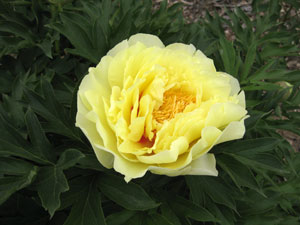Resource Library
Plant of the Week: Peonies, Itoh Hybrid
The University of Arkansas System Division of Agriculture does not promote, support or recommend plants featured in "Plant of the Week." Please consult your local Extension office for plants suitable for your region.
Plant of the Week
Itoh Hybrid Peonies
Latin: Paeonia Itoh hybrid 'Bartzella'

Peonies are - along with daylilies, daffodils, hostas, irises, azaleas and roses - one of the garden plants that have inflamed the passions of gardeners across the ages and throughout the world. Like the other “biggies” in the garden world, there are thousands of selections grown in gardens and hundreds of cultivars in the garden trade at any moment in time. Knowing them, even as nodding acquaintances, requires a passion and single-mindedness I lack, but that doesn't mean they aren't interesting and beautiful. A year ago, wondering through the fields of a local peony grower, I happened upon a yellow herbaceous peony that was new to me and deserved a closer look.
The peony I spotted was Paeonia Itoh hybrid 'Bartzella', a yellow-flowered plant with leaves and flowers closely resembling the tree peony, but with a plant form reminiscent of the common herbaceous peony. In the peony world, these hybrids are called either Itoh hybrids or Intersectional hybrids. 'Bartzella' has 8-inch, double lemon-yellow blooms marked with a few small red flashes towards the center of the blossom. It grows 3 feet tall on stout stems that hold the large flowers above the characteristically cut tree peony-like foliage. The plant is a vigorous grower that was introduced in 1986 by Roger Anderson, one of the preeminent peony breeders of this group.
The 280 or so peony species found throughout the world are divided into two sections, the herbaceous kinds and the “tree” (really shrubs) kinds. Though the chromosome number (2n=10) is the same in the two sections, breeders had tried but always failed when attempting to crossbreed between plants with the two different growth forms.
But in 1948 Toichi Itoh, a hobby breeder in Tokyo, Japan, succeeded in crossing a white-flowered herbaceous plant (P. lactifolia 'Kakaden') with pollen from a yellow-flowered woody plant (P. x lemoinei).This was not a case of beginner's luck, for Itoh had been attempting to make this cross for years. One report says it was one of 20,000 crosses he made during his lifetime. Unfortunately, Itoh passed away in 1956 and never saw his plants flower, which they did in 1964.
Fortunately, Louis Smirnow (1896-1989) of Brookville, N.Y., got wind of them and secured six (one source says all) of the plants from Itoh's widow in 1966 while traveling in the Orient. Smirnow, a retired accountant who became a stockbroker after retirement, became interested in tree peonies in 1931, when he and his wife bought their first home. His passion for the plant grew, and he eventually opened a mail-order nursery specializing in tree peonies. He traveled extensively in his search for tree peonies, even convincing the Chinese to allow him into the county in 1979, about five years before most Westerners were permitted into the nation.
In 1974 he registered four of the hybrids as Itoh Smirnow hybrids, calling them 'Yellow Crown', 'Yellow Dream', Yellow Emperor' and 'Yellow Heaven'. A decade later, American breeders such as Roger Anderson and Don Hollingsworth began introducing their own intersectional hybrids. Because these hybrids could only be propagated by division, they remained expensive (in the $300 to $1,000 range) - until the early years of the current century, when a Canadian firm called Plantek began mass producing the Itoh peonies in tissue culture. Of the 30 Itoh cultivars listed in their current catalog, none of the original Smirnow introductions are listed, being superseded by better selections in a range of typical peony color forms and bloom types.
The Itoh hybrids are vigorous plants that tend to be shorter than most herbaceous species. Instead of disappearing completely below ground in winter, many intersectionals have inch-long stubby, woody stems at the ground line. Stems tend to be stronger than their herbaceous cousins, holding the flower comfortably above the foliage. Bloom time varies but is usually a few days earlier than the herbaceous species and a week or two later than the woody kinds. Like all peonies, they should be given a full sun location and a good, well drained garden soil. The hybrids seem to have excellent disease resistance and are expected to be extremely long-lived, like all peonies.
By: Gerald Klingaman, retired
Retired Extension Horticulturist - Ornamentals
Extension News - April 29, 2011
The University of Arkansas System Division of Agriculture does not maintain lists of retail outlets where these plants can be purchased. Please check your local nursery or other retail outlets to ask about the availability of these plants for your growing area.